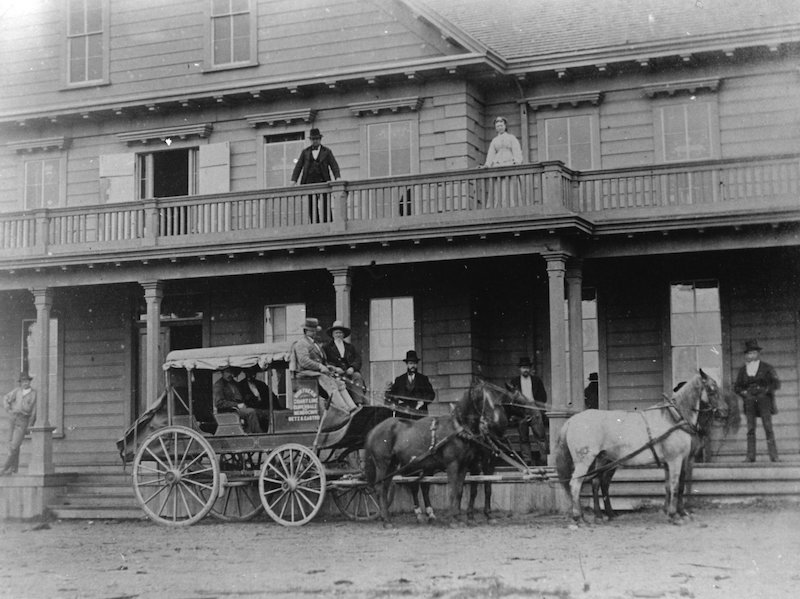Until the 1870s, the Mendocino coast was isolated except for the schooners that sailed between San Francisco and Eureka. Travel inland was on foot or by horseback over narrow ridge trails worn by the local native peoples. During the 1860s, roads began to be built between Mendocino and Ukiah and Mendocino and Cloverdale. According to Elsa E. Thompson’s 1973 Early Settlers of Comptche Along Its Many Roads, “The Low Gap Road was built in 1874 by William Heeser of Mendocino, owner of The Mendocino Beacon.” It was first called Heeser Road and it was said that Mr. Heeser walked the entire area in order to determine where the best location and grades were.
By 1886, several stagecoaches arrived in Mendocino each day. Early editions of The Mendocino Beacon tell us that the stages were the large four-seated variety drawn by either four- or six-horse teams. They seated 12 people, with two riding on top with the driver. A later Beacon article reported that “The Mendocino and Ukiah Stage Company commenced this week to run two-horse stages instead of four as heretofore, and as a consequence, stages arrived later.”

The Coastline Mendocino to Cloverdale Stage, operated by Getz & Castro, in front of Carlson’s City Hotel on Main Street, Mendocino
As for passenger comfort (or lack of it), besides the closeness of the quarters, there was the ceaseless rocking of the coach. It rested on a suspension system of two long leather straps that were anchored to the coach at the front and rear axles; this created a ship-like motion as the stagecoach heaved and plunged along steep roads that had little grading. The passengers rode three abreast, squeezed into back and middle rows, both facing forward, and into a forward row, facing rearward. The facing passengers in the forward and middle rows had to ride with their knees dovetailed. The passengers rode with baggage on their laps and mail pouches beneath their feet.
Because the stages carried gold, there were many robberies in Mendocino County during these years. In fact, the county has sometimes been called one of the lawless parts of the West. Interestingly, according to Laura Hopper Sankey in Mendocino Beginnings, the last shooting holdup in the county, in March of 1903, was on the Ukiah Road about 26 miles east of Mendocino. The coach was attacked by a lone highwayman who shot and killed one man, but the driver, Harry Owsley, drove the horses to a gallop and carried the treasure box to safety. The robber was never caught.
Driving three or four sets of horses over the narrow, bumpy mountain roads was no easy task. Added to that, the driver had to manage his team in all kinds of weather. In summer, the air was so clouded with dust that driving was dangerous. In winter, the roads were full of mud and the stagecoach wheels might sink up to the hub.
Stagecoach drivers were highly respected for their ability to handle the horses and, although many were regarded as characters (some enjoyed that role and took pains to live up to it), all were well aware of their responsibilities. They had to have sound judgment and a capacity for quick decisions. Was there a highwayman just around that next bend?
Some “rules of the road” when traveling by stagecoach were:
- Don’t grease your hair because travel is dusty.
- Don’t swear or flop over your neighbors when sleeping (if you can sleep).
- Never shoot on the road as the noise might frighten the horses.
- If the team runs away with the coach, stay put and take your chances. If you jump, you will get hurt.
- If you have anything to drink in a bottle, pass it around.
- But in very cold weather abstain from liquor because you will freeze twice as quickly when under the influence.
- Don’t complain about the food at the way station.
- Spit on the leeward side.
- Expect annoyances, extreme discomfort, and possible holdups.
The Kelley House Museum is open from 11AM to 3PM Thursday through Monday. If you have a question for the curator, contact her at curator@kelleyhousemuseum.org to make an appointment. Walking tours of the historic district depart from the Kelley House regularly.